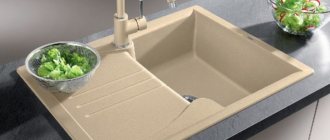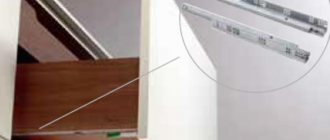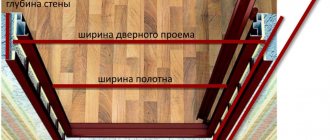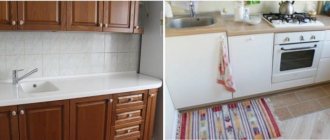Sinks made of artificial stone differ in shape, material structure, surface texture and design.
They are designed to replace less practical and more expensive natural stone models. A natural sink is carved from a single piece of natural stone. The process is labor-intensive and requires a large amount of high-quality material.
The artificial sink material includes quartz or granite chips, binder resins and dyes. Depending on the type of stone, the percentage of natural stone chips and binding resins, as well as the method of producing a slab of stone, differs.
According to the manufacturing method, shells are divided into two types:
- Factory production. They have standard sizes and shapes.
- Made to order from a slab of artificial stone according to individual drawings. They can be integral with the tabletop, being made from the same material.
Installation of a kitchen sink made of artificial stone, made according to individual drawings, is carried out at the factory, simultaneously with the production of the countertop itself.
Serial sinks are usually installed where the countertop is installed.
Installation of a sink in an artificial stone countertop
Product Catalog
- Artificial stone countertops
- Window sills made of artificial stone
- Artificial stone tables
- Artificial stone sinks
- Bar counters for cafes and restaurants
Fake diamond
It's hard to imagine a kitchen without a sink. This is an element of primary importance, the quality of installation of which determines the comfort of all kitchen processes.
The kitchen sink should be deep enough to make it convenient to wash dishes. Kitchen sinks are usually made from stainless steel or artificial stone.
Options for installing a sink in a countertop
There are several ways to install kitchen sinks:
- Overhead. With this installation option, the sink is placed on top of the countertop. The installation process is simple, but there are gaps between the countertop and the sink into which water and food debris can get in.
- Mortise. This technology involves inserting the sink into a special hole in the countertop.
- Podstolny. An interesting mounting option in which the sink is installed below the countertop.
When choosing a sink installation method, you should rely not only on the complexity of the procedure. But also take into account the materials used to make the countertops and sinks.
An overhead sink is a budget option. It is more suitable for the bathroom than for the kitchen. The installation process is limited to securing the product with self-tapping screws and sealant in specially prepared places in the cabinet.
Installing a sink into a stone countertop
Carefully installing a sink into an artificial stone countertop is not so easy. If experience and knowledge are not enough, it is better to use the services of specialists.
In other cases, first you need to prepare the tools:
- grinder;
- self-tapping screws;
- metal drill and drill with a diameter of 10 mm;
- colorless silicone sealant;
- building level and tape measure;
- Phillips screwdriver;
- construction knife, ruler, pencil, corner.
The first step is to mark the location of the future drain on the countertop. After this, you should outline the contours of the sink on the table surface.
Before cutting the hole, it is advisable to make holes in the corners to make the process easier. When cutting through the tabletop, you need to make sure that the cut piece does not fall out at the end.
For countertops made of plastic or other materials, you can use an electric grinder. A grinder will only be needed for stone products.
The cut on the countertop made of artificial stone is treated with sandpaper and sealant.
A sealant is glued to the sides of the sink, and fastening devices are not completely installed on the inside. At this stage, you can carefully insert the sink into the hole until it meets completely and completely fix the fasteners.
The final stage is connecting hot and cold water.
Installing a sink under a stone countertop
Washing option. Placed below the countertop level is good. That the entire load to which the product is exposed during use falls on a special substrate made of chipboard or MDF, resting on the frame of the kitchen module.
The installation process is as follows:
- in the base of the countertop (up to the layer of artificial stone), a hole is cut about 2 cm larger than the sink (for a round sink, the hole is also made square);
- the upper side of the sink is processed with a grinding machine;
- a square is cut out of the prepared plywood base, as in a tabletop, inside of which a hole is cut according to the internal dimensions of the sink itself;
- the sink is glued to the cut hole in the countertop;
- a prepared sheet of plywood, chipboard or MDF is glued on top;
- a hole is cut out in the artificial stone from the front side, the edges are processed with sanding paper.
The process of installing an undermount sink in an artificial stone countertop is clear to everyone, but doing it yourself is quite difficult. Especially. That you will need a special tool. Therefore, it is better to resort to the help of craftsmen and be confident in the quality of installation of the product.
Installation of a sink in an artificial stone countertop
Installation of a sink in an artificial stone countertop
Sinks made of artificial stone differ in shape, material structure, surface texture and design.
They are designed to replace less practical and more expensive natural stone models. A natural sink is carved from a single piece of natural stone. The process is labor-intensive and requires a large amount of high-quality material.
The artificial sink material includes quartz or granite chips, binder resins and dyes. Depending on the type of stone, the percentage of natural stone chips and binding resins, as well as the method of producing a slab of stone, differs.
According to the manufacturing method, shells are divided into two types:
- Factory production. They have standard sizes and shapes.
- Made to order from a slab of artificial stone according to individual drawings. They can be integral with the tabletop, being made from the same material.
Installation of a kitchen sink made of artificial stone, made according to individual drawings, is carried out at the factory, simultaneously with the production of the countertop itself.
Serial sinks are usually installed where the countertop is installed.
Installation of ventilation systems- Pipes for internal sewerage
How to choose a window sill?
Sink material
Features of installing an artificial stone sink into a countertop directly depend on the type of material from which it is made.
Factory sinks are made of composite material. Each manufacturer uses its own recipe, which, as a rule, is not disclosed. The approximate composition looks like this: 80% quartz or granite chips, 20% binder resins, a small amount of dyes. Using a vibratory casting installation, a material with the required properties is produced, which is cast into a matrix of the desired configuration.
The best sinks are those that contain granite and quartz chips (sand). There are several main large productions with a similar recipe, but different names:
- silgranite sinks (BLANCO);
- fragranite sinks (FRANKE);
- CRISTALITE+ and CRISTADUR (SCHOCK);
- ceramic sinks (BLANCO and SCHOCK) made of porcelain stoneware;
- quartz sinks from quartz agglomerate manufacturers. They are made from the same material as quartz slabs. During installation they can form a single monolithic structure with the tabletop
Acrylic sinks and sinks made of cast marble stand out.
Acrylic sinks contain a large percentage of acrylic resins and less mineral filler, and therefore have more modest technical characteristics. They require careful operation due to their higher porosity and lower hardness than the above materials. They can irreversibly absorb dyes; over time, visible scratches and stains appear on the surface from contact with hot cookware.
Cast marble is made from marble chips and polyester resins. Loses in technical characteristics to its competitors. One of the advantages is the ability to manufacture a product of any shape. The cost of producing an individual product is not high, since it does not require complex production equipment.
Edge at the end
The principle applies here: the simpler the edging, the cheaper the final price of the tabletop. The cost also depends on the thickness of the product.
The following types of edges can be distinguished:
- straight end;
- radius;
- semicircular;
- beveled;
- curly.
The shapes of the ends can also be designated in the form of letters: Z, H, F, V, A, O, L, D.
Options for processing end edges with profiles can be divided into two large groups:
- standard edges (profiles):
- edges with gluing.
Complex edges are more appropriate in classic kitchens. If the kitchen design is made in a modern style with a predominance of monochrome colors and straight lines, then a simple edge with a minimal radius or chamfer will look more natural on a quartz countertop.
FEATURES OF INSTALLING SINS IN STONE COUNTERTOPS
There are several options for installing a sink:
- bottom mounting;
- top mounting;
Installation of PVC windows- Covering the drain hole with your own hands
- How to lay flexible tiles on the roof?
- flush with the tabletop.
Installation of a sink made of artificial stone, depending on the type, has its own characteristics of preparation and implementation.
- As a rule, the sink comes with a template for cutting a hole in the countertop. In the absence of a template, its role can be played by the sink itself, which is outlined along the contour for subsequent cutting of a hole for it.
- For a sink that is built flush with the countertop, it is necessary to mark the second contour in order to then remove the material and install the sink. If the sink has a complex curved shape, it is recommended to make a template with which to make a cut in the countertop.
- When making cutouts in the tabletop, it is recommended to maintain a minimum radius in the corners of at least 15mm. The distance between the cutout and the edge or seam of the tabletop must be at least 60mm. The greater the distance, the stronger the area.
- When installing a sink under an artificial stone countertop, the visible edges of the cutout in the countertop must be rounded and sanded.
- When installing from above, the edges of the tabletop are ground with a grinding wheel, without polishing.
- With the built-in installation type, the product is mounted completely flush with the countertop, similar to the installation of a cone into a cone. The edge of the product should be slightly wider at the top edge than the bottom. It is necessary to make a hole in the tabletop at a slight angle to create a cone shape so that the cutout at the top is wider than at the bottom. The product can be built into a cutout. The size of the cutout is determined by the position of the product in relation to the surface.
Kitchen sink accessories
Modern fine water purification devices take up quite a lot of space under the bowl. They must be located in such a way as to ensure accessibility for servicing.
Purified water flows through a separate tap, under which an additional hole is cut out in the horizontal panel of the sink next to the mixer.
To avoid frequent blockages of the sewer drain pipe, install a garbage disposer in the sink drain hole. The grinder has an electric drive and a blade head, through which large particles are ground to a finely dispersed state.
In some cases, the drain hole in the sink is closed with a valve grid. The device is equipped with a button, when pressed, the grille becomes impenetrable to water. This drain allows you to accumulate the required volume of water at the required temperature - for soaking very dirty dishes or for defrosting food in plastic packaging.
Installation of an integrated sink
Installation of a sink made of acrylic stone or quartz agglomerate, made according to individual drawings, is carried out under production conditions.
There are 2 types of integrated sinks:
- bottom mounting, with a slight overhang of the countertop over the sink;
Sinks made to order from countertop material are visually very attractive. There are 2 important points to consider. The corners and edges of sinks cannot be rounded, which complicates maintenance. The design of the sink is not monolithic, like factory sinks, but is glued together from segments, which makes it less durable. This type of washing requires careful operation. Increased load should be avoided. The installation of a waste shredder that creates vibration is highly undesirable.
PROFESSIONAL ADVICE
The best option from the point of view of the balance of beauty and functionality are factory sinks of under-table (bottom) installation with additional structural reinforcement.
Our company’s specialists will select a design that suits your individual requirements.
We are waiting for you for consultation in our showrooms, as well as on-line consultation through feedback forms on the website or by phone +7(495)212-18-29.
Installation of an artificial stone sink into a countertop
Today we will talk about how to install an artificial stone sink. Everything is extremely simple.
How to properly lay a vapor barrier on the ceiling?- Is it possible to glue wallpaper on whitewashed walls?
- Imitation of a brick wall made of gypsum plaster
Approximate marking and installation time: 20 – 30 minutes
Sink gluing time 4-6 hours
Step-by-step installation of an artificial stone sink
It is much easier to embed and install a sink made of artificial stone than one made of stainless steel. Or rather, it’s easier to attach it, but the rest is still the same. But the fact of the matter is that attaching a stainless steel sink can sometimes be very difficult.
I already wrote about the step-by-step installation of a stainless steel sink, now about the step-by-step installation of a stone sink.
The first stage of installation is marking, the second is sawing, the third is covering the cut with silicone sealant. I will simply copy all these three stages from the previous post.
STAGE 1. Looking for a location
The first task is to decide where it is best to place the sink. Let me explain - in our example, the sink is round, 51 cm in diameter, and the cabinet itself is 80 cm, therefore, it can be moved to the left or right, or embedded in the center.
When marking the sink, pay special attention to the corner version (90 gr. version) of the kitchen, since the convenience of approaching the sink depends on your choice.
STAGE 2. How much to retreat from the wall?
Having decided on the location, place the sink on the countertop with the bottom facing up. Now you need to decide how much you need to retreat from the wall.
This point is especially important if your sink is 51 cm deep. If such a sink is placed exactly in the middle of the countertop, then there is a high probability that your saw will pass along the front plank of the cabinet (this depends on the design of the cabinet itself).
The easiest way is to place a kitchen plinth against the wall and move 1-2 cm away from it. This place will be the outer edge of the sink. If the sink is shallower, then it makes sense to move the sink further away from the wall.
TIP: If the cut line still goes along the body of the cabinet, then you need to either pull off the bar of the cabinet, or remove the tabletop from the body, cut it out and put it back in place.
Take a pencil and outline the outer contour of the sink.
STEP 3. Draw a cutting line
We have outlined the outer contour of the sink. Now we need to decide on the line of the cut itself.
To do this, you need to measure the distance from the outer edge of the sink to the beginning of the installation edge (sawed groove along the edge, from the bottom of the sink). Usually this size is 1-3 cm, but it may vary for different sinks.
We already have a drawn line of the outer contour of the sink. Now we measure the just measured distance from it into the future sink and draw the internal contour. This is the cutting line. It happens that the installation edge on the sink is not level. Then you can take the smallest edging size.
It's okay if the sink doesn't fit tightly into the hole. After gluing it will stand like a glove.
Stage 4. Ewing
Using a drill, from inside the contour, next to the cut line, we make a through hole. We do it so that the jigsaw blade can pass through.
Use a jigsaw to cut along the contour of the cut. When cutting, do not rush and do not press forward with the jigsaw, but press the jigsaw against the tabletop.
It is better to cut with a “Clean Cut” blade. If the sink is rectangular, then to prevent chipping, you can use masking tape. When choosing a file, consider the cutting height.
Stage 5. Preparing the cut
After cutting, you need to process the edges of the cut.
We level the cut with coarse sandpaper and try on the sink.
If everything is fine, then we clean the saw cut from dust and coat it with silicone sealant. Silicone will subsequently prevent the tabletop from absorbing moisture and swelling.
Stage 6. Glue the sink
This is the easiest installation step. On the very edge of the cut we squeeze out a small path of silicone sealant (for kitchens and bathrooms). Next, we install and center the sink, that is, we place it the way it should be.
Tip: Before gluing in the sink, you need to install the faucet, screw the hoses into it and install the overflow hose on the sink. These elements are very difficult to install on an already glued sink.
Next, we press down the sink with a weight, for example, a bucket of water.
We wipe off the squeezed-out excess silicone from the tabletop with a rag (it can be washed off well with polyethylene film). And wait several hours until the sealant dries completely.
If you have not completely installed the fittings (siphon, drain...) on the sink, then install it on the already glued sink. We check the joints for water leaks and rejoice at the work done.
—>
- Like
- Tweet
- Pin It
My name is Oleg, I created and am leading this project. My work is related to interior design and furniture production. I want to share my experience and cool ideas with you, I can help you with choosing an interior design or furniture.
Choice and savings
Countertops made of quartz composite are quickly and confidently gaining a place in the market. Let's look at the basic rules on how to choose and order this product without overpaying.
Tip 1. Cheap does not mean low quality.
In the CIS countries, quartz agglomerate is represented by many brands from different continents. Some of them have already confidently taken a position in the market, while others have arrived relatively recently - and therefore maintain a low pricing policy in order to win customer loyalty.
Among the famous manufacturers:
- Radianz/Lotto (South Korea);
- Plaza Stone (Russia);
- Vicostone (Vietnam);
- Caesarstone (Israel);
- Technistone (Czech Republic);
- Quarella, SantaMargherita (Italy);
- Silestone (Spain);
- DuPont Zodiaq (Canada).
Products from China and other Asian countries are widely represented, and the quality is no worse than their European counterparts.
Tip 2. Save money when choosing colors.
Any manufacturer of stone countertops works with several brands of quartz agglomerate. Each brand usually provides about 30 colors and textures of the material. Some shades overlap between different brands, so the advice is this:
Select 3-5 color swatches you like; find out their cost; ask which collections are the most budget-friendly and choose the colors you need from them.
The cost of a countertop largely depends on the cost of the material, so you can save big by following this advice.
Tip 2. Save on texture.
Due to the specifics of its production, the cost of different textures of quartz agglomerate can vary significantly. Therefore, countertops of a single color with small inclusions will cost you less than options with imitation natural stone.
Of course, the marbled texture will look more elegant, but are you willing to pay 2-3 times more for such a solution?
There is an exception to this rule. Plain countertops are cheaper - but this does not apply to white. The fact is that pure white color is very difficult to obtain when making a quartz composite.
Tip 3. Size doesn't always matter
The standard size of a quartz slab is 3000 by 1400 mm. The countertop manufacturer can purchase at least 3000 by 700 mm of material (half a slab cut lengthwise). Therefore, even if you need a 1-meter tabletop, or even a 2-meter one, you will pay the same as for 3 meters.
In this case, there are a couple of ways to save:
- Check the availability of scraps from the company where you are going to order the tabletop. Of course, in this case the choice of colors will be very limited, but you will be able to save a lot;
- If, after installing a quartz countertop in the kitchen, you have a large scrap left over, think about where you can attach it. Perhaps you need a bathroom countertop, table or window sill.
Tip 4. A 40mm thick worktop is cheaper than a 30mm thick one.
The standard thickness of quartz slabs is 20 mm and 30 mm.
These slabs make countertops in the following sizes:
- 20 mm - one layer of slab 20 mm wide;
- 30 mm - one layer of slab 30 mm wide;
- 40 mm - one layer of slab 20 mm wide + an edge glued along the front side to create the appearance of a wide tabletop.
Thus, the cheapest tabletop will be 20 mm, more expensive - 40 mm, and even more expensive - 30 mm.
Tip 5. Order the countertop separately from the kitchen
No matter how strange it may sound, it is better to order a countertop made of quartz agglomerate not from where you order your kitchen set. Most likely, the furniture retailer will purchase this countertop from a third-party manufacturer and sell it to you at a 15-20% markup.
What else affects the cost of a quartz countertop:
- figured front edge - some exclusive options are comparable in cost to the cost of the countertop;
- wall plinth - it will be made for you from the remnants of the sheet that remained after making the tabletop. If the height of the plinth is large, you will have to pay for another half of the slab 3000 mm by 700 mm;
- type of installation of sink and hob . It will be cheaper to install an overhead or undermount sink, but an undermount sink and a flush-mounted hob will be more expensive.
Recommendations for choosing a contractor who will make the countertop:
- check which brands and materials it works with . A reputable company will not offer you 20 brands at once, but will recommend only those whose quality they are responsible for and with whom relationships and supplies have been fully established;
- to work with quartz stone you need to have significant experience - since it is a rather complex material that requires expensive and precise equipment;
- openness and accessibility - ask if you can look at the production and meet the people who will do the work. If you do not receive a clear answer, there is a high probability that other third-party contractors are involved. This may increase the order execution time and deteriorate its quality;
- look at the portfolio - any self-respecting company should have examples of completed work, and ideally, a showroom;
- pay attention to how quickly the contractor’s employees answer your questions , make calculations and provide the necessary information, and whether it is easy to reach the company by phone.
Quartz stone is a difficult material to process and does not tolerate an amateurish approach, so we advise you to take a responsible approach to choosing the manufacturer of your countertop.
The procedure for installing an artificial stone sink into a countertop
In the process of renovating a kitchen, furnishings are chosen not only by visual perception, but also by their functionality, practicality and durability. No kitchen is complete without a sink. But the choice of their models is so large that it is difficult to settle on the right model. If you take durability as a guide, then you should choose a sink made of artificial stone, and not stainless steel or ceramics.
Artificial stone is made using vibration casting, thereby obtaining a durable and homogeneous material. Its composition includes 80% chips from natural granite or marble and 20% adhesive resins, and also adds various dyes for beauty. To close all the pores, the top is covered with a special gelcoat substance.
Sinks made of artificial stone vary in texture: plain, contrasting, coarse-grained and fine-grained. According to texture - matte, glossy, shagreen, silky matte.
Texture affects not only the visual appearance, but also the difficulty of cleaning, the appearance of scratches and other things.
It is sinks made of artificial stone that have a wide variety of shapes to suit every client’s taste. They come in classic shapes, “shell”, “butterfly”, with one or two bowls.
According to the method of installation, sinks made of artificial stone are divided into the following: overhead (they are the simplest, they are placed on a floor cabinet without a countertop), mortise (to match or in contrast with the countertop) and integrated (the most modern, they are mounted flush with the countertop, made from the same material, this composition looks like a single whole).
There are many advantages of artificial stone when choosing a sink material. First of all, it is resistance to temperature changes from -30 to +150 degrees and to the effects of chemical elements - acids, solutions and other reagents. And there’s no need to talk about durability; the stone will withstand a blow from any kitchen item.
The main advantage of such a product is that it is easy and simple to care for, so the appearance will always be perfect.
Caring for such a sink is easy and simple; there will be no bacteria, plaque, odor, or radiation. Even if a scratch or pothole appears somewhere, these defects will be very easy to eliminate. The service life of an artificial stone sink in your kitchen will be more than a dozen years.
In order to install a countertop made of artificial stone and a sink made of the same material with high quality, you need to very carefully monitor the tightness of all joints of these components.
Colors and textures
Correctly selected color and texture of a quartz countertop will create the ideal interior of your kitchen, which will be a pleasure to be in and cook in.
The shade depends on the amount of color pigments in the mixture. Modern technologies make it possible to create black, white, pink, yellow, red, gray, purple countertops. Such products will fit perfectly into kitchen interiors in country, loft, classic, and Provence styles.
Pay attention also to the surface, it can be:
- polished, glossy with a mirror shine;
- matte;
- slightly polished, with roughness.
The appearance of the finished countertop depends on the chosen color of the stone. For example, on plain black or white products it is difficult to hide the joint (seam), but on beige or cream products it will be difficult to see even under a magnifying glass.
Preparation
Before starting installation you need to go through the following steps:
The first is to prepare the entire necessary set of tools: electric drill, 10 mm drill, jigsaw, self-tapping screws, tape measure, pencil, ruler, knife, Phillips screwdriver, construction angle, silicone sealant.
The second is to measure the sink as accurately as possible to cut an opening in the countertop.
And that’s it, now you can start installation!
Regardless of the shape, installing an artificial stone sink into a countertop begins with markings:
- Most often, the manufacturer completes the stone sink with a template for cutting out a hole for it. If there is no such template, the sink is placed on the countertop and traced along the contour with a pencil or marker.
- For a mortise sink, which is installed on top of the countertop, it is necessary to apply a second contour along which the cut will be made. The difference between the lines is the width of the sink rim, usually 12 - 15 mm. With the correct shapes of the sink, there are no difficulties in applying the 2nd line, but for curved ones it is better to make a template. A fragment of a thin lath can be used as a material. By methodically applying it to the contour, you will be able to draw its exact repetition.
- First, glue the area where you drank it with molar tape; this simple step minimizes the likelihood of chips appearing on the surface of the tabletop.
- Holes are drilled in the corners of the internal contour for inserting a jigsaw file.
- Use a jigsaw to cut out a hole for the sink. The piece being cut should be supported from below to prevent it from splitting when it is almost sawn off.
- To protect the countertop from swelling in the event of accidental moisture getting under the side of the sink, the edges of the cut are treated with silicone sealant, distributing it over the entire cut area. Aquarium sealants are best suited for this purpose; a thin layer of which will reliably protect the MDF board.
- Attach the brackets to the sink. Each of them has 2 legs in its design, which must be carefully driven with a hammer and a punch into specially designed holes.
- Depending on the manufacturer, the sink may be equipped with holes for the mixer. In this case, it is necessary to apply a chipper or a screwdriver to the place of the drink, and knock out the cork with a light blow of a hammer.
- But not all samples provide such a service, so if it is not there, you need to arm yourself with a Forstner drill or a bimetallic cutter. Using a conventional ceramic drill, a small recess is drilled to support a Forstner drill or crown. In non-impact mode, drills drill a hole of the required diameter, the edges of which are then polished.
- Apply a layer of adhesive sealant around the perimeter of the cutout and install the artificial stone sink, pressing it tightly to the surface.
- I snap the brackets into place at the bottom of the sink and securely fix them with the installed hardware.
- After this, the mixer and sewer siphon are installed.
- Remove excess sealant from the front side of the countertop.
The installation of a sink made of artificial stone into a countertop made of marble and quartz agglomerate is carried out in a similar way.











